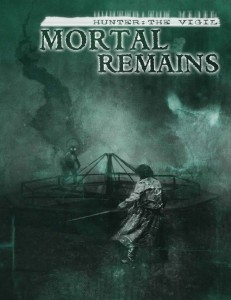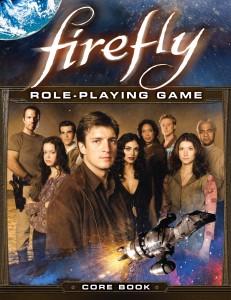
In my free time, I’ve been playing around with the idea of translating Cortex Plus Action into other genres, and I have to say our motto that failure is interesting for the Firefly RPG made me think about how that would work for a dark fantasy or horror scenario. Of course, a Cortex Plus Fantasy system (and other fabulous hacks!) already exists, and that is available in the Cortex Plus Hacker’s Guide. For me, this line of thought is an exercise to bend the confines of Action. Why am I using that as the base? I’ve been neck-deep in the Firefly RPG for months, and my brain tends to be inspired by what I’m working on more than what I read.
Picture a scene where you and your cabal are attempting to perform rituals on All Hallows’ Eve due to the thinning of the veil between worlds. Maybe this grand ritual is to protect an entire town from malevolent spirits. Maybe the spell will unravel the laws of reality and you want to transport the town to the underworld.
In my worlds/settings, whichever world that happens to be, magic always comes at a cost. With this in mind, I was pondering what would happen in a Cortex Plus Action scenario where witches and warlocks collected various elements, tossed them into a cauldron, and the spell-of-their-design would either succeed or fail.
Dice-wise, using Cortex Plus Action as the base, here’s how I envision this would break down. It’s pretty rough since I haven’t playtested this at all, but hopefully you get the gist of where I’m going with this in its very basic form.
Your basic rolls remain the same: Attribute + Skill. Your Distinctions would be Traits D8 that shape the type of witch/wizard you are, and the triggers help you accomplish your goal in that vein. (e.g. You might be an Adept who’s keen on Elemental Magic who’s also an Herbalist.) However, to perform a spell you’re required to use Assets that are part of your stated intent for your roll. Mugwort. Hellsbane. Eye of newt. Etc. The more in line your Distinctions are with your Assets thematically, the more you get to use those dice. For this reason, I’d likely create categories of Assets to use as a guide that may work with various Distinctions representing schools of magic. That’s not to say that creativity shouldn’t be rewarded, but if dice are to be rolled that make sense for the fiction, then I feel the fiction needs to be clearly outlined–and there are a lot of variables to magic systems in general.
When you roll dice to perform a spell, you’re rolling against the laws/fabric of reality. So the GM would pick scene Traits that reflect how challenging it would be to accomplish your task. The scale for difficulty would remain the same, with D12 being the toughest. In some cases, you may also be rolling dice against an opponent of an opposite alignment. Going back to the iconic forces of good vs. evil, for example, you could be rolling dice to shield your entire cabal with a magical defensive barrier while another warlock is trying to set the group on fire with a supernatural form of dragon’s breath. I’ve got a very rough idea that GMCs could be supernatural or biological in nature to flesh out the setting.
Assets are important in my supernatural scenario, and right now I’m thinking they would be assigned to the elements in your spell, with a variable rating. Signature Assets would also have a variable rating, and they align with your goals as well. In a game like this, Assets would cost variable amounts to encourage Asset creation. Two Plot Points might get you one rare D4 Asset, while One PP might get you two D12 commonly found Assets. Similarly, I am also playing around with the idea that some spells yield new Assets when you succeed by 5 or higher, or that you could trade in your variable Assets for a new Asset with a higher die type once per scene. Maybe it’s a 2:1 scenario all the way through. 2D12 Found for 1D10 Common; 2D10 Common/4D12 Found for 1D8 Average and so on.
I imagine Complications that result from your rolls would likely be negative effects from failed rituals when you incorporate those Assets, but might scale more scene-or-setting based when you’re taking other actions that don’t require the use of magic. If you were to roll all 1s, that roll would end in the transformation of the spellcaster to an entity like a poltergeist or some other monster. Hint: I’m really keen on this idea, and want to playtest this further.
Once you’re no longer human, the Distinctions you chose at the start would continue to impact your actions in this state, and would shape how you interact with the living. Though botches might be rare, I’m considering what might happen if the positive aspect of your Distinction was only rolled when you were human, and negatively when you weren’t. Again, you can see how freeform this line of thought is, and why playtesting to work out the kinks would be important.
Now, here’s the tricky part: the Asset/Sig Asset rating. Right now, I’m leaning toward using D4s as rare, unstable, dangerous or poisonous items, whereas more common items come in at a D12. I realize that rating scale is counter-intuitive to how many die ratings normally work, but here’s my thought on this: when you add various elements to perform your spell, success should be easier when you use everyday, commonly found items. It’s only when you pick up and find the rare items that failure becomes interesting, and if you add the wrong element or the stars just aren’t right? Well, that’s when you have a greater chance of your proverbial luck turning sour.
Last but not least? I’d tweak the Lending a Die mechanic to encourage multiple spellcasters to try and pool together Assets and I’d also encourage group usage/creation/trading of available Assets as well. Signature Assets are, to me, something that you use as your lucky charm or part of your ritual that helps distinguish your character, and I rather like that those shouldn’t be shared at the same rating when they’re given to another player. A wand. A cauldron. An amulet. A phylactery. A familiar. Any resulting Complications from a lent die would be an area effect that would impact the whole cabal/coven/circle as opposed to multiplying Complications–with the exception of a botch. IF you are casting a master ritual AND you manage to muck it up so badly that all 1s are rolled? I think those townspeople might have to start running…
Anyway, with Halloween and my novel revisions on my mind this weekend (Can’t you tell I’m starting to hang art up on my walls…FINALLY?) I thought I’d throw out this off-the-cuff train of thought about using Cortex Plus Action in a dark fantasy game. I’m in the mood for magic. Don’t forget! For a finished, polished hack that uses Cortex Plus, be sure to check out the aforementioned Cortex Plus Hacker’s Guide and get thee to rolling!
Mood: Creative!
Caffeinated Beverages Consumed: I’m chemicalized.
Work-Out Minutes Logged Yesterday: Um… I’d better get on that!
In My Ears: Cat. Whining.
Game Last Played: Age of Reckoning: Kingdoms of Amalur.
Book Last Read: Re-reading His Dark Materials trilogy by Phillip Pullman
Movie Last Viewed: Lucy
Latest Artistic Project: Um…
Latest Fiction/Comic Release: Last Man Zombie Standing. See also: need to write more flipping comics and exercise my art skillz again. Feh.
Latest Game Release: Mortal Remains
What I’m Working On: Primarily tie-in games work, original comics, and novels.



